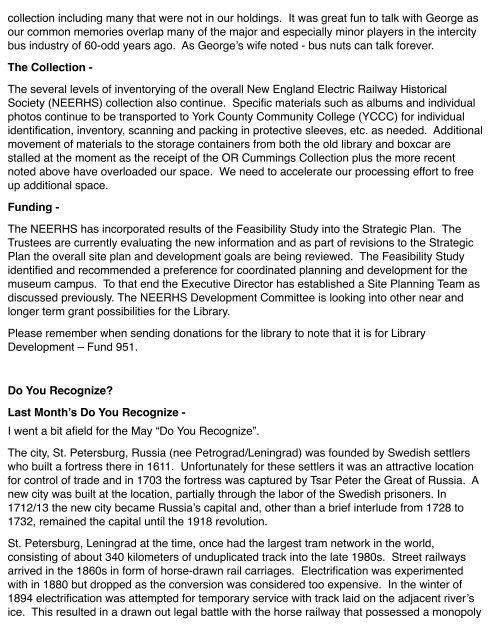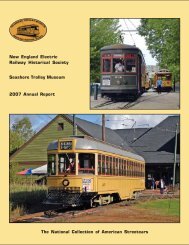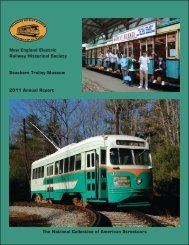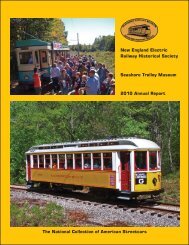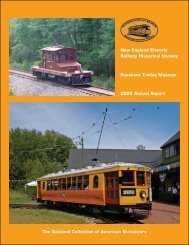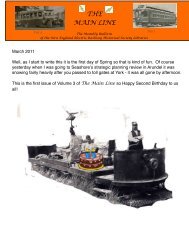June 2013 Main Line vol5 No4 - Seashore Trolley Museum
June 2013 Main Line vol5 No4 - Seashore Trolley Museum
June 2013 Main Line vol5 No4 - Seashore Trolley Museum
Create successful ePaper yourself
Turn your PDF publications into a flip-book with our unique Google optimized e-Paper software.
collection including many that were not in our holdings. It was great fun to talk with George as<br />
our common memories overlap many of the major and especially minor players in the intercity<br />
bus industry of 60-odd years ago. As George’s wife noted - bus nuts can talk forever.<br />
The Collection -<br />
The several levels of inventorying of the overall New England Electric Railway Historical<br />
Society (NEERHS) collection also continue. Specific materials such as albums and individual<br />
photos continue to be transported to York County Community College (YCCC) for individual<br />
identification, inventory, scanning and packing in protective sleeves, etc. as needed. Additional<br />
movement of materials to the storage containers from both the old library and boxcar are<br />
stalled at the moment as the receipt of the OR Cummings Collection plus the more recent<br />
noted above have overloaded our space. We need to accelerate our processing effort to free<br />
up additional space.<br />
Funding -<br />
The NEERHS has incorporated results of the Feasibility Study into the Strategic Plan. The<br />
Trustees are currently evaluating the new information and as part of revisions to the Strategic<br />
Plan the overall site plan and development goals are being reviewed. The Feasibility Study<br />
identified and recommended a preference for coordinated planning and development for the<br />
museum campus. To that end the Executive Director has established a Site Planning Team as<br />
discussed previously. The NEERHS Development Committee is looking into other near and<br />
longer term grant possibilities for the Library.<br />
Please remember when sending donations for the library to note that it is for Library<br />
Development – Fund 951.<br />
Do You Recognize?<br />
Last Month’s Do You Recognize -<br />
I went a bit afield for the May “Do You Recognize”.<br />
The city, St. Petersburg, Russia (nee Petrograd/Leningrad) was founded by Swedish settlers<br />
who built a fortress there in 1611. Unfortunately for these settlers it was an attractive location<br />
for control of trade and in 1703 the fortress was captured by Tsar Peter the Great of Russia. A<br />
new city was built at the location, partially through the labor of the Swedish prisoners. In<br />
1712/13 the new city became Russia’s capital and, other than a brief interlude from 1728 to<br />
1732, remained the capital until the 1918 revolution.<br />
St. Petersburg, Leningrad at the time, once had the largest tram network in the world,<br />
consisting of about 340 kilometers of unduplicated track into the late 1980s. Street railways<br />
arrived in the 1860s in form of horse-drawn rail carriages. Electrification was experimented<br />
with in 1880 but dropped as the conversion was considered too expensive. In the winter of<br />
1894 electrification was attempted for temporary service with track laid on the adjacent river’s<br />
ice. This resulted in a drawn out legal battle with the horse railway that possessed a monopoly


